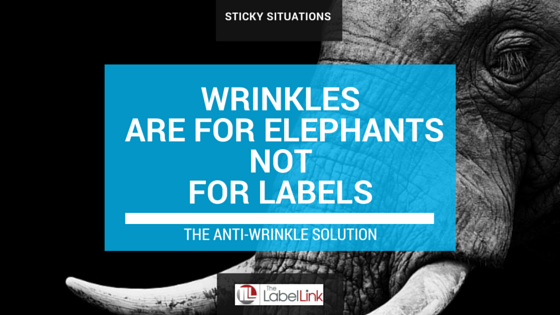
Peel and stick. Seems simple enough. Yet when the fit is off, you’re using the wrong adhesive, or the temperature changes, you could be faced with an unexpected problem – wrinkles.
Wrinkles are never a welcome sight. On clothes, skin, and labels wrinkles give the look being old, worn and unkempt. Is that how you want your brand to look to your customers? Probably not.
Here are a few ways to keep your labels from wrinkling.
Find the Right Fit
Every bottle, can, and container are shaped differently. As your label hugs the side of your product’s packaging, it has to fit in just the right way. If not, it’ll wrinkle.
Before you place your order, make sure the dimensions are suitable for the container in which you are labeling. You must have a clearance from any of the curves or bottle shoulders. This clearance is generally about one-eighth of an inch, give or take from all sides.
In addition, you’ll want to ensure the surface is flat, or it has a large curve. Trying to squeeze your label snuggly over a tight corner will make it hard to uphold its visual appeal.
Application
The way your label is applied is equally as important. Just because a label fits properly doesn’t mean it’ll go on smoothly.
One of the best ways to avoid common application issues is to have a large enough wipe blade. This will help you keep everything smooth and even as you apply your label.
You should also steer clear from high tack adhesives that stick too quickly. This type of adhesive doesn’t allow you to properly place your label before adhering tightly, causing gaps and wrinkles. Instead, opt for an adhesive that allows you to reposition the label while you’re applying it to the product. This type of adhesive will build adhesion over time, usually within the first 12 – 24 hours after application.
Watch the Mercury
The type of material you’re applying your label to matters. Plastic bottles expand and contract with the temperature. Your label will appear to be applied smoothly, then a few hours later, it’ll start to wrinkle because the temperature changed.
To avoid this natural size change, your must apply your label in a way that can move with the bottle as the mercury rises and falls. The trick is to use a repositionable label. This type of adhesive is softer and takes more time to bond, allowing the label to move naturally with the plastic containers and bottles.
Another consideration is to use a similar type of material so that it also moves and contracts with the container. For example, it would be better to apply a polypropylene label to a polypropylene bottle. A paper label on that same container may tend to wrinkle more as paper does not expand/contract when the mercury rises or falls.
The bottom line is this. You can’t afford to send products filled with wrinkled labels to market. With the right fit and the right adhesive, you can sleep better at night knowing your labels will always look good from the storeroom to the shelf and beyond.
Question: Have you’ve ever seen a product on the shelf with wrinkles, what was your impression? Please note your answer in the comments section.
Wrinkles happen to the best brands. It’s nothing to worry about, but it is something you can actively work to avoid.
We have the anti-wrinkle solution team. Shoot us a quick email with your particular application issue and we will be happy to reply to you with some troubleshooting ideas. And, if you like these tips and want more, direct to your inbox, don’t forget to check the box when you send us that email.
